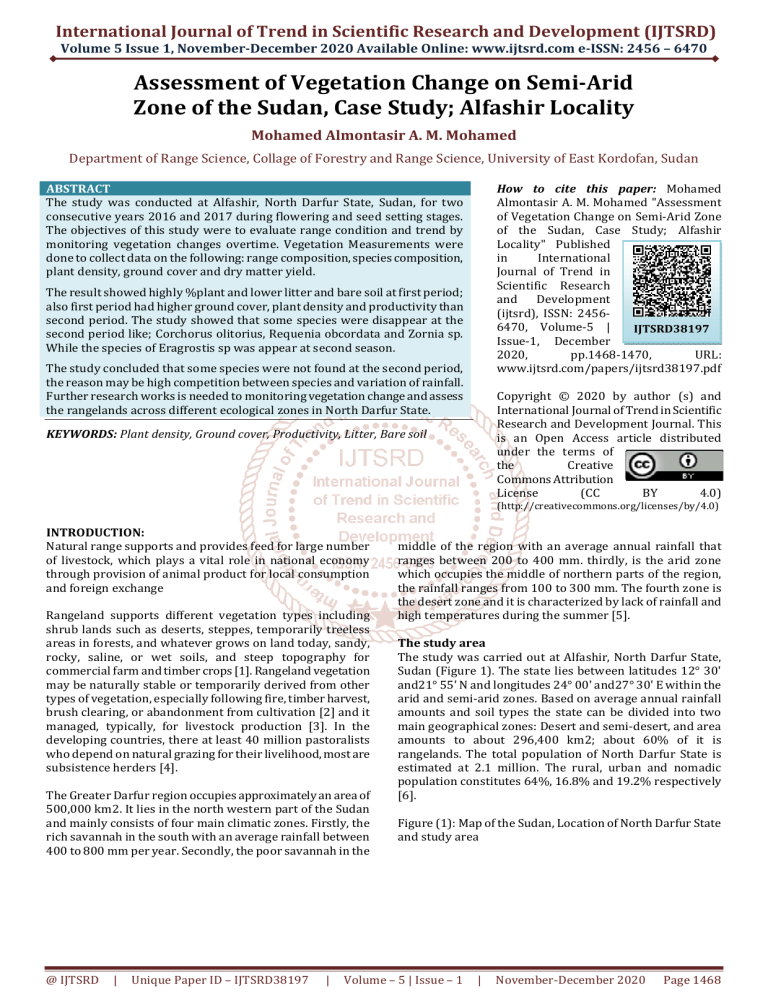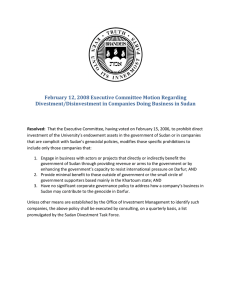
International Journal of Trend in Scientific Research and Development (IJTSRD)
Volume 5 Issue 1, November-December 2020 Available Online: www.ijtsrd.com e-ISSN: 2456 – 6470
Assessment of Vegetation Change on Semi-Arid
Zone of the Sudan, Case Study; Alfashir Locality
Mohamed Almontasir A. M. Mohamed
Department of Range Science, Collage of Forestry and Range Science, University of East Kordofan, Sudan
ABSTRACT
The study was conducted at Alfashir, North Darfur State, Sudan, for two
consecutive years 2016 and 2017 during flowering and seed setting stages.
The objectives of this study were to evaluate range condition and trend by
monitoring vegetation changes overtime. Vegetation Measurements were
done to collect data on the following: range composition, species composition,
plant density, ground cover and dry matter yield.
How to cite this paper: Mohamed
Almontasir A. M. Mohamed "Assessment
of Vegetation Change on Semi-Arid Zone
of the Sudan, Case Study; Alfashir
Locality" Published
in
International
Journal of Trend in
Scientific Research
and Development
(ijtsrd), ISSN: 24566470, Volume-5 |
IJTSRD38197
Issue-1, December
2020,
pp.1468-1470,
URL:
www.ijtsrd.com/papers/ijtsrd38197.pdf
The result showed highly %plant and lower litter and bare soil at first period;
also first period had higher ground cover, plant density and productivity than
second period. The study showed that some species were disappear at the
second period like; Corchorus olitorius, Requenia obcordata and Zornia sp.
While the species of Eragrostis sp was appear at second season.
The study concluded that some species were not found at the second period,
the reason may be high competition between species and variation of rainfall.
Further research works is needed to monitoring vegetation change and assess
the rangelands across different ecological zones in North Darfur State.
Copyright © 2020 by author (s) and
International Journal of Trend in Scientific
Research and Development Journal. This
is an Open Access article distributed
under the terms of
the
Creative
Commons Attribution
License
(CC
BY
4.0)
KEYWORDS: Plant density, Ground cover, Productivity, Litter, Bare soil
(http://creativecommons.org/licenses/by/4.0)
INTRODUCTION:
Natural range supports and provides feed for large number
of livestock, which plays a vital role in national economy
through provision of animal product for local consumption
and foreign exchange
Rangeland supports different vegetation types including
shrub lands such as deserts, steppes, temporarily treeless
areas in forests, and whatever grows on land today, sandy,
rocky, saline, or wet soils, and steep topography for
commercial farm and timber crops [1]. Rangeland vegetation
may be naturally stable or temporarily derived from other
types of vegetation, especially following fire, timber harvest,
brush clearing, or abandonment from cultivation [2] and it
managed, typically, for livestock production [3]. In the
developing countries, there at least 40 million pastoralists
who depend on natural grazing for their livelihood, most are
subsistence herders [4].
The Greater Darfur region occupies approximately an area of
500,000 km2. It lies in the north western part of the Sudan
and mainly consists of four main climatic zones. Firstly, the
rich savannah in the south with an average rainfall between
400 to 800 mm per year. Secondly, the poor savannah in the
@ IJTSRD
|
Unique Paper ID – IJTSRD38197
|
middle of the region with an average annual rainfall that
ranges between 200 to 400 mm. thirdly, is the arid zone
which occupies the middle of northern parts of the region,
the rainfall ranges from 100 to 300 mm. The fourth zone is
the desert zone and it is characterized by lack of rainfall and
high temperatures during the summer [5].
The study area
The study was carried out at Alfashir, North Darfur State,
Sudan (Figure 1). The state lies between latitudes 12° 30'
and21° 55' N and longitudes 24° 00' and27° 30' E within the
arid and semi-arid zones. Based on average annual rainfall
amounts and soil types the state can be divided into two
main geographical zones: Desert and semi-desert, and area
amounts to about 296,400 km2; about 60% of it is
rangelands. The total population of North Darfur State is
estimated at 2.1 million. The rural, urban and nomadic
population constitutes 64%, 16.8% and 19.2% respectively
[6].
Figure (1): Map of the Sudan, Location of North Darfur State
and study area
Volume – 5 | Issue – 1
|
November-December 2020
Page 1468
International Journal of Trend in Scientific Research and Development (IJTSRD) @ www.ijtsrd.com eISSN: 2456-6470
Source: Adam, 2013
Materials and methods
The field work was carried out at the rainy season (Flowering stage) and the end of rainy season (Seed setting) (late August and
late October) for two consecutive years (2016 and 2017). Ten transects 100m long were taken and two quadrates in each
transect were chosen. The measurement tools consisted of measuring tape (100 meter), loop (3/4 diameter), quadrate (1x1m2)
and recording sheet.
The samples were taken from two sites, open and protected area (one hectare in each site) to evaluate range condition and
trend by monitoring changes vegetation overtime.
Vegetation Measurements were done to collect data on the following: Range composition, species composition, plant density,
ground cover and dry matter yield.
Information used in the attainment of this study included both primary and secondary data. Primary data were vegetation
measurements collected from open and protected area, sources of secondary data were published and unpublished reports and
studies covering variety of related topic to the study area. Three variables were measured. These are: the number of live plants,
the litter quantity and the area of bare soil. When the skinned process had happened, they were transformed in percentage.
Excel software program was used to organize and tabulate the collected data. Rangeland standard assessment equations were
used.
Results and discussion
Table (2) shows the range composition during both periods (2016 and 2017), first period during flowering stage had highest
%plant and lowest %litter and %bare soil, while second period during seed stage had lowest %plant and highest %litter and
%bare soil. This variation may be due to the amount of rainfall. Harrison and Jackson 1958 stated that range components are
influenced by amount of annual rainfall.
The percentage of plant species composition are showed in the table (3), in the second period at seed stage Blepharis linarifolia
records highest percent about 40.18%, this study observed that some species had disappears at second season, this result may
be due to the high competition between plants and some species had highest roots to get water from underground.
Range attributes were show in the table (4), first period had higher plant density, cover and productivity, and this may be due
to the management systems. The results support the finding of WSARP (1985) [7] that herbaceous productivity was generally
higher inside protected range than outside, this is because the protected range was not subjected to removal of plants by
animals or damage by humans, while the difference within the same area from year to year is attributed to differences in
annual rainfall amount.
Table (1): Annual rainfall at Alfashir locality at seasons 2016 and 2017
Season May June July August September October Total
2016
24
27
99
186.4
21.1
3.1
360.6
2017
-16
136.9
91.3
14
-258.2
Source: [8]
@ IJTSRD
|
Unique Paper ID – IJTSRD38197
|
Volume – 5 | Issue – 1
|
November-December 2020
Page 1469
International Journal of Trend in Scientific Research and Development (IJTSRD) @ www.ijtsrd.com eISSN: 2456-6470
Table (2): Range composition in the study area at seasons 2016 and 2017
Season
Stage
Plant Litter Bare soil
Flowering stage
90
2
8
2016
Seed stage
76
7
17
Flowering stage
81
6
13
2017
Seed stage
66
12
22
Table (3): Percent of plant species composition at seasons 2016 and 2017
2016
2017
Species
Flowering stage Seed stage
Aver
Flowering stage Seed stage
Aristida sp.
13.35
26.77
20.06
18.64
23.28
Blepharis linarifolia
19.23
18.70
18.95
38.34
40.18
Cenchrus biflorus
10.41
10.34
10.37
07.37
07.01
Chloris prieurii
05.07
03.54
04.31
06.01
12.88
Corchorus olitorius
00.67
01.98
01.33
00.00
00.00
Dactyloctenium aegyptium
18.56
15.44
17.00
06.77
06.26
Eragrostis sp.
00.00
00.00
00.00
02.26
00.00
Ipomoea sp.
06.81
05.24
06.03
10.68
02.75
Requenia obcordata
05.07
03.68
04.38
00.00
00.00
Tribulus terrestris
08.28
03.54
05.91
03.61
03.38
Zalya pentandra
06.94
04.68
05.81
06.32
04.26
Zornia sp.
05.61
06.09
05.85
00.00
00.00
Total
100.00
100.00
100.00
100.00
100.00
Aver
20.95
39.26
07.19
09.45
00.00
06.52
01.13
06.72
00.00
03.49
05.29
00.00
100.00
Table (4): Range attributes in the study area at seasons 2016 and 2017
Season Density (plant/m2) Cover% Productivity (ton/ha)
2016
58
64
1.593
2017
43
49
1.409
References
[1] Grice, A. C., Campbell, S., Breaden, R., Bebawi, F. and
Vogler, W. (2008). Habitat management guide—
Rangelands: Ecological principles for the strategic
management of weeds in rangeland habitats. CRC for
Australian Weed Management, Adelaide.
[2]
Heady, H. F. and Child, D. (1994). Rangeland Ecology
and Management. West view Press, San Francisco, CA.
[3]
Holechek, J. L., R. D. Pieper and C. H. Herbal. (2004).
Range management principles and practices. (5th ed).
Pearson Education. Inc. upper Saddle River, New
Jersey.
[4]
Elnour, I. A, (2007). Competition on Range Resources
and its Impact on social situation in Darfur. Case
study (Eddaein locality), South Darfur State, Ph.D
thesis, College of Forestry and Range Science. Sudan
University of Science and Technology- Sudan
@ IJTSRD
|
Unique Paper ID – IJTSRD38197
|
[5]
Fadul, A. A. (2009). Environmental and Resource
Issues
as
factors
in
African
conflict.
www.africa.upeace.org/documents/environment
files.pdf
[6]
Adam, A. I. (2013). Study on Impact of Darfur Armed
Conflict on Vegetation cover, Case study: Umkaddada
Locality, North Darfur State –Sudan, PhD thesis,
Sudan University of Science & Technology, College of
Graduate Studies
[7]
WSARP. (1985).Western Sudan Agricultural Research
project, Transhumant production system 1984/1985
Research results WSARP publication No, 43. Kadugli
Research Station. Sudan
[8]
Alfashir Research Station. (2013). Annual report of
range and forage research program, Agricultural
Research Corporation, Sudan
Volume – 5 | Issue – 1
|
November-December 2020
Page 1470




